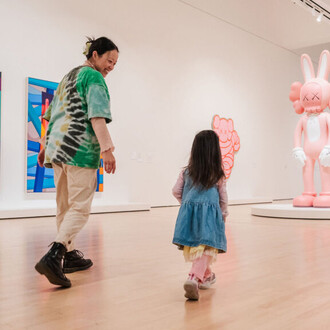Jerry Kearns grew up in a churchgoing Baptist family in North Carolina in the 1940s and began his New York art career as a member of a seriously leftist Anti-Imperialist Cultural Union in the 1970s. And something like that surreal clash of cultures has fueled his work since. They are in a style that Mr. Kearns refers to as “psychological pop,” meaning Pop with a moral consciousness. The art of James Rosenquist and Andy Warhol had this element, too, particularly early on, but for Kearns it’s the whole story, though he’s less and less given to spelling out clear political positions.
(Holland Cotter, The New York Times, August 15, 2014)
Modernism is pleased to present FACT WITNESS, a painting exhibition by Jerry Kearns. This is the artist’s 10th solo show with the gallery. This exhibit features 8 new paintings, completed over the past three years. Each canvas is 84 inches in height and varying widths. The size repetition lends a cinematic, interrelated and overlapping reading of the images.
Kearns talks about the origins of the works: When my wife, singer songwriter, Nora York, was diagnosed with advance pancreatic cancer in 2015, our lives exploded. Nothing would ever be the same. Nora had fourteen months to live. What would we do? We talked about trying to stay sane when waking everyday with that knowledge. Among many decisions, we decided to collaborate and make art and music about what it is like when time turns around and starts coming at you, like a runaway freight train.
In July, Nora and I presented Diva’s Song, a summer-long mural installation at the Mike Weiss Gallery, NYC. Nora and her band performed in Joe’s Pub, at the Public Theater, on July 29. Inspired by Puccini’s Opera, “Tosca,” the mural installations composed a kind of theater. The viewer walked through a metaphor for supreme loss, our reality at the time. The installation was a way to demonstrate our love for each other in the nightmare. At the end of the summer the paintings were sanded away and painted over to begin a new season.
I think of the paintings in FACT WITNESS as continuing the story. These works, which I began shortly after losing Nora in 2016, were at the time of their making, a form of magical thinking. Daily, I worked at recreating Nora, brush stroke by brush stroke. I was aware of tapping into the spiritual/ritual core of why we make art. There is something very magical about that split-second sensation when my brush touches the canvas and transfers energy into metaphor.
One of art’s deepest powers lies in telling the story of its time. In contributing to that narrative, the artist connects individuals to each other in the present, and over long periods of time. At the core of that purpose is the power and means to describe oneself. When I undertake to transfer my love of Nora to metaphor, I am translating myself.
Our relationship to time zoomed to high relief after the explosion of Nora’s diagnosis. We lived a nightmare. Facing the reality of losing each other, we entered another reality. For weeks, I woke in the morning, wanting to go back to our other life. Each day, we had to face that we couldn’t, would never, return to that life. At night, I had dreams of seeing Nora without skin on parts of her body.
There were long periods of feeling suspended, a woman on a still trapeze, stopped in time and space. We were walking along an edge between being and non-being. Everything you were and knew grows distant. You feel out of sequence with others, isolated in an unknowable rapidly changing reality. Our personal story was surrounded and framed by a fast-changing America. I was increasingly feeling the insanity of the ceaseless flow of misleading alternate facts, where there is no truth, where everything is transactional. I felt an inflated mad Joker had taken power, and he held deeply disturbing authoritarian tendencies.
As one of the most astute political artists of our time, Jerry Kearns has been calling our society on its cultural bullshit for decades now in about the only way we can ever see the truth: through the vulgar dishonesty of pure visual seduction.
(Carlo McCormick, PAPER magazine, June 2, 2014)
Jerry Kearns has exhibited internationally across the Americas, Europe and Asia. His work has been featured in The New York Times, Artforum, Art in America, Artnews, among others. His works are included in many public and private collections, including The Museum of Modern Art (New York), National Galerie (Berlin), Brooklyn Museum (New York), The Art Institute of Chicago (Chicago), Whitney Museum of American Art (New York), and many others. Jerry Kearns lives and works in New York City.
















